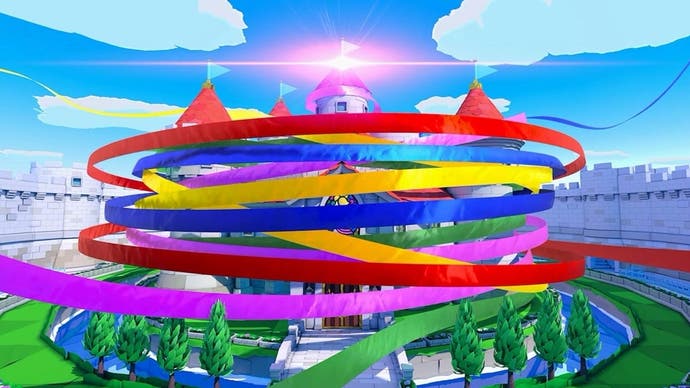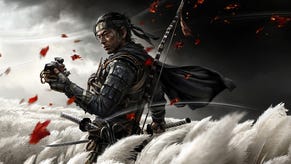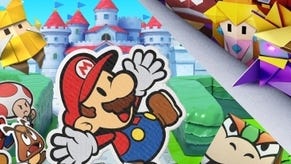Paper Mario: The Origami King review - a heartfelt creation that doesn't quite stand up
Pulp friction.
There's always been something unique in Paper Mario's wafer thin worlds: a sense of place and personality, an ability to linger and explore, a chance to stop and befriend. In its cardboard castles and papercraft dioramas, Paper Mario's mix of adventuring and role-playing has always managed to showcase Mario's surroundings as more than just background scenery, spotlight sidekicks or rivals and make them more than just one-dimensional, and be that rarest of things for video games - frequently very funny. Within its creases and corrugated backdrops, Paper Mario has consistently shaped the Mushroom Kingdom and its inhabitants into something more textured and weighty than its materials might ever suggest. Happily, you'll find much of the same heart, humour and character once again in The Origami King.
But Paper Mario has also experienced a tug of war between its adventuring and role-playing mechanics, with recent entries opting to fold away their RPG gameplay and keep it tucked out of sight. For many, this tussle goes beyond simple genre preference - it is central to Paper Mario's premise, and to its ability to present Mario's worlds and characters in a way only this series, which comes around rarely, is able to provide. As more of The Origami King emerged during its remarkably short route to reveal and then release, Paper Mario fans (and particularly those of hallowed GameCube entry The Thousand-Year Door) desperately tried to pigeonhole this latest incarnation as one thing or another - adventure or RPG? - to determine the kind of experience it might offer. In reality, it is an odd jumble of both. The Origami King does offer a few welcome concessions to its RPG roots, but it also shies away from growing these further over the course of the game, struggling to ever emerge truly distinct.
The Origami King's battle system is a good example of all this. Its turn-based gameplay using well-timed jumps and hammer swings will be a familiar sight for Paper Mario purists, while the addition of a grid layout to rotate and shuffle enemies into more manageable groups adds a fun new puzzle layer. It's a battle system you will see an awful lot of over the course of the game, but one which continually provides a feeling of accomplishment when you line everything up just right. There are a few items (Fire Flowers, POW Blocks and the like) you can use or mostly ignore, and a neat help system which sees you calling on the assembled Toad audience to jump in and mark out a route for you.
You'll quickly gain access to 1000-Fold Arms, a special move you can perform either with motion controls or a combination of buttons within certain tougher battles and at specific points in the game's world to uncover your route forward. But the vast majority of your time battling will still be spent jumping and hammer swinging - the game does not integrate or add further special attacks for the vast majority of its encounters. Boss battles bring in four simple elemental powers, which again can be used at a handful of specific moments in the game's world, but these are rare exceptions rather than the norm.

Many of the decisions developer Intelligent Systems has made surrounding the game's battle systems feel tied to a larger hesitancy around deeper RPG mechanics - one which leaves The Origami King in a place where your health meter is the only stat number to ever appear on screen. Battles earn you coins rather than XP, to be spent on Toad assistance in battles, better gear and collectibles. Levelling is non-existent, though your health is expanded at intermittent moments by specific characters, some hidden and seemingly possible to miss. Your strength increases each time your health is upgraded, which means you carry your starting level boots and hammer to the game's final boss fight (and also that these are always your default option if your better gear breaks, because of course, that has limited durability).
Mario is sometimes assisted in battle by a party member, but the game features no method of selecting who or how they attack - something which unfortunately reflects on how little companions matter mechanically overall. The return of party allies was interpreted as a major move back towards the game's RPG origins, but most characters you meet will only travel with Mario temporarily, and even then will decide to sit out certain sections. Apart from Olivia, a chatty Navi-like character who enables Mario's 1000-Fold Arms attack, only one party member will ever appear on screen in battle at a time, and only then to perform a basic jab at random intervals.

It's a shame, as The Origami King introduces and then quickly leaves behind a list of promising party member candidates, some of whom are roped in for a matter of minutes before departing again. Hi Luigi! Bye Luigi. The game's script is often brilliant, its command of paper-based wordplay continually razor sharp, and yet many of its characters end up feeling underserved by their screen time. There are several cameos from fan-favourite characters and plenty of knowing nods to Nintendo's history. There are scene-stealing turns from Bowser's overlooked dogsbody Kamek and the capricious Bowser Jr. But the transient nature of these party members means some arrive too late to make an impression, while earlier characters are never given the chance to properly bed in. There are also a couple of decidedly downbeat story moments which jar with the overall tone of the game - which stand out enough to flag here but are also not worth spoiling.
Over the course of its story, The Origami King will take you to a ninja-themed theme park, an angelic spa resort, an ocean cruise liner, to jungles, canyons and woods. Each has been lovingly crafted in wonderfully tactile paper and cardboard. Each has their own secrets, Toads in need of rescue who will join your battle audience, torn scenery needing repair using your bag of paper confetti. Rarely will you find an area without something hidden in plain sight, and someone with dialogue which will make you smile. These areas are mostly linear - the game has a set story it wants to tell, and apart from hoovering up collectibles there are no side-quests to be found, or reasons to return.

Two large open world areas traversed via vehicles are also included - a desert you zoom across in a motorised boot, and a Wind Waker-esque sea you sail in a boat, uncovering islands and marking them on your map. Both of these sections offer a break from the pace of the rest of the game, though also stretch things out considerably, with treasure hunts that will likely leave you with a bit of trial and error. Throughout the game there are moments played for laughs where Mario will seemingly find himself at the end of an area, ready to complete it, only for something to happen and another huge section to unfold. By the end, you may find yourself dreading the next time this happens - such as at the end of one late section where to progress you must take part in one of the series' trademark game shows, a surprise distraction which sits oddly with the pace of the game's final few hours.
There's plenty I'd recommend about The Origami King, a journey generous with its humour, its spread of locations, its continual sense of adventure in Mario's bid to defeat the evil Origami King (a clever conceit which lets Mario befriend regular paper Goombas and Koopas while also letting him battle evil origami Goombas and Koopas). Its final section especially, while brief, is thrilling to watch unfold. But each time the game changed settings, every time it swapped in a new party member, whenever I cleared another boss, I expected it to grow the shoots it had begun to set out and dig in a little deeper. For all of the game's sense of personality and place, it never grows into anything weightier.








